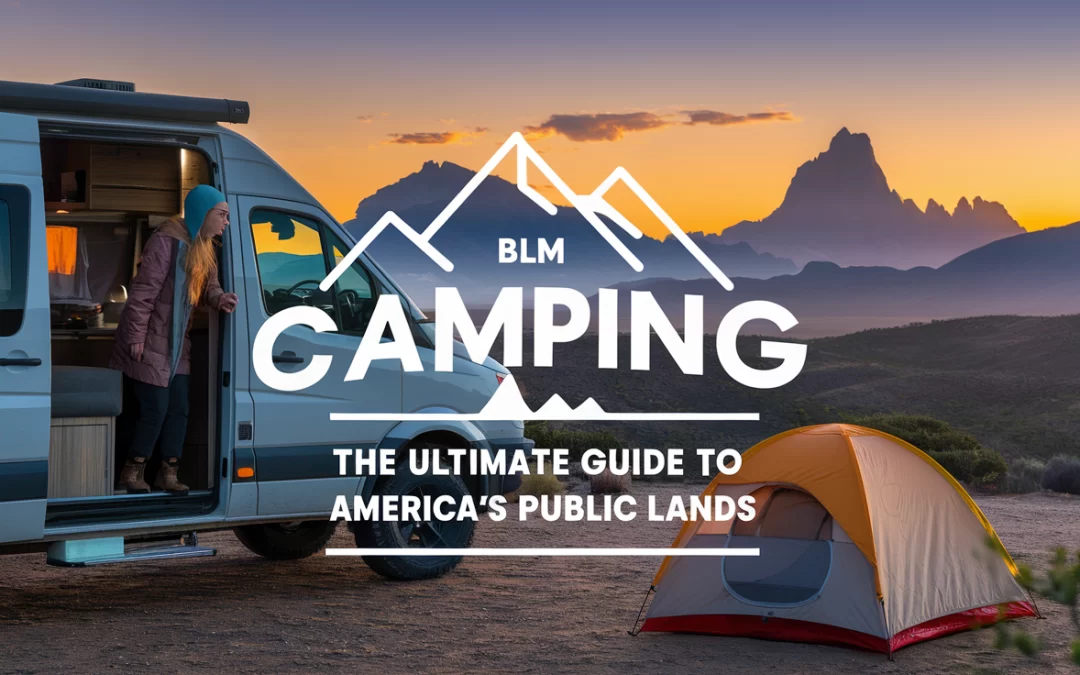The Call of the Wild
Imagine waking up to the gentle rustling of leaves, the soft chirping of birds, and the warm glow of the rising sun peeking over distant mountain peaks. As you unzip your tent, you’re greeted by a vast expanse of untouched wilderness stretching as far as the eye can see. This is not just a dream—it’s the reality of BLM camping, an increasingly popular way to experience the great outdoors in its purest form.
In recent years, Bureau of Land Management (BLM) camping has surged in popularity, offering outdoor enthusiasts an unparalleled opportunity to connect with nature. The COVID-19 pandemic acted as a catalyst, driving a remarkable 30% increase in outdoor recreation as people sought safe, socially-distanced ways to escape the confines of their homes and rediscover the healing power of nature.
This comprehensive guide will take you through everything you need to know about BLM camping, from its basics and benefits to practical tips and popular destinations. Whether you’re a seasoned camper looking to explore new territories or a novice eager to embark on your first wilderness adventure, this article will equip you with the knowledge and inspiration to make the most of America’s public lands.

What is BLM Camping?
BLM camping refers to camping on the vast tracts of land managed by the Bureau of Land Management, a federal agency within the United States Department of the Interior. The BLM oversees an astounding 245 million acres of public lands, primarily in the western United States. These lands range from arid deserts and rolling grasslands to dense forests and rugged mountains, offering a diverse array of landscapes for outdoor recreation.
Types of BLM Camping
When it comes to BLM camping, there are three main types, each offering varying levels of amenities and solitude. Whether you prefer the convenience of a developed campground or the solitude of dispersed camping, BLM lands provide a range of options to suit your style of adventure.
Developed Campgrounds
Developed campgrounds are perfect for those who want to enjoy nature without sacrificing basic comforts. These sites typically offer amenities designed to make your stay more convenient and enjoyable. They are often ideal for families, first-time campers, or those traveling in RVs. You can expect to find:
- Designated campsites
- Picnic tables
- Fire rings or grills
- Vault toilets
- Sometimes potable water
These campgrounds may charge a nominal fee and are often located near popular hiking trails or other recreational activities. To find developed campgrounds, you can explore the BLM’s official recreation site.
Primitive Campgrounds
If you’re looking for a more rustic experience, primitive campgrounds might be the perfect choice. These areas offer fewer amenities than developed sites, but still provide some conveniences, making them a great option for those who want to get off the beaten path without going fully off-grid. At primitive campgrounds, you’ll find:
- Designated campsites
- Vault toilets
- No potable water
Primitive campgrounds are often located in more remote areas and may not require a camping fee. These locations provide a peaceful retreat from busier campgrounds while still offering a few essential amenities.
Dispersed Camping
For the true adventurer, dispersed camping offers the ultimate wilderness experience. Dispersed camping is allowed in many areas of BLM land and permits campers to set up camp almost anywhere, provided it’s outside of developed campgrounds. This form of camping is ideal for those seeking solitude and self-reliance. However, it’s important to note that with dispersed camping, you must be fully prepared, as there are:
- No designated campsites
- No facilities (no restrooms, no potable water)
- Complete self-reliance is required
Dispersed campers must practice Leave No Trace principles to protect the environment. Since dispersed sites are often in remote areas, be sure to bring everything you need, including water, food, and a means to dispose of waste responsibly.
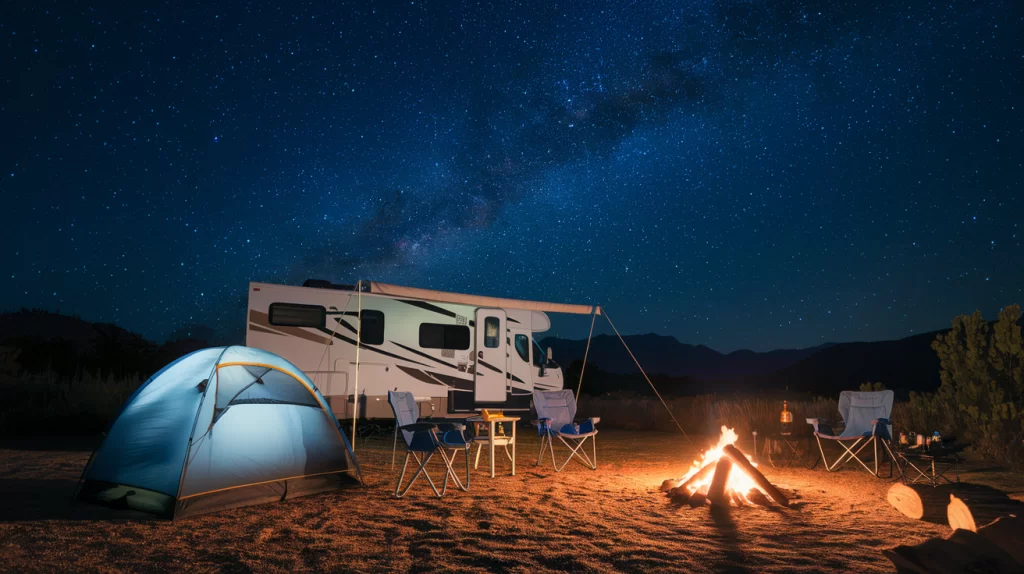
Why Choose BLM Camping?
BLM camping has gained traction among outdoor enthusiasts for several compelling reasons, making it one of the most appealing options for those looking to experience nature on a deeper level. Here are some of the top reasons why BLM camping might be perfect for your next adventure:
Cost-Effective
One of the primary draws of BLM camping is its affordability. Many dispersed camping areas are completely free, while developed campgrounds charge minimal fees compared to state or national parks. This makes BLM camping an excellent option for budget-conscious travelers who still want to experience the beauty of nature. For more information on fees and camping costs, visit the BLM’s recreation fee page.
Scenic Locations
BLM lands often encompass some of the most breathtaking natural settings in the country. From the towering red rock formations of Utah to the coastal bluffs of California, these public lands offer stunning landscapes that rival the beauty of national parks, but without the crowds.
Less Crowded
Unlike popular national parks, which can be crowded during peak seasons, BLM sites are generally more secluded. This allows for a more peaceful and immersive outdoor experience, where you can truly disconnect from the hustle and bustle of everyday life.
Flexibility
Dispersed camping on BLM land offers unparalleled flexibility. You can choose your own campsite away from designated areas and large crowds, allowing you to find the perfect spot to set up camp and enjoy the wilderness. For more details on dispersed camping guidelines, check the BLM camping site search tool.
Diverse Activities
BLM lands are a playground for outdoor enthusiasts, offering a wide range of recreational activities. Whether you enjoy hiking, fishing, rock climbing, mountain biking, or off-road vehicle use, there’s something for everyone. The BLM provides detailed guides on permitted activities across their lands, which you can explore here.
Wildlife Viewing
The vast, often undisturbed nature of BLM lands makes them ideal for wildlife observation. Many species of birds, mammals, and other wildlife can be observed in their natural habitats, offering a unique opportunity for nature lovers and photographers.
Stargazing
Many BLM sites are located far from urban centers, minimizing light pollution and providing spectacular night sky views. For those who enjoy stargazing, camping in remote BLM areas can offer some of the clearest skies in the country. Consider visiting National Conservation Lands for pristine stargazing opportunities.
Educational Opportunities
BLM lands are often home to sites of historical, cultural, or geological significance. From ancient petroglyphs to dinosaur fossils, these lands offer a chance to learn about the rich natural and human history of the region. The BLM regularly updates its cultural heritage program, offering insights into these fascinating locations.
Potential Drawbacks of BLM Camping
While BLM camping offers solitude and freedom, there are a few potential downsides to consider:
- Lack of Amenities: Many BLM sites are primitive, meaning no toilets, potable water, or firewood.
- Limited Cell Service: In remote areas, you may be off the grid completely, so it’s important to plan ahead for communication and emergencies.
- Permitting and Restrictions: In some high-traffic or sensitive areas, obtaining a permit can be time-consuming, and there may be restrictions on group size and camping locations.
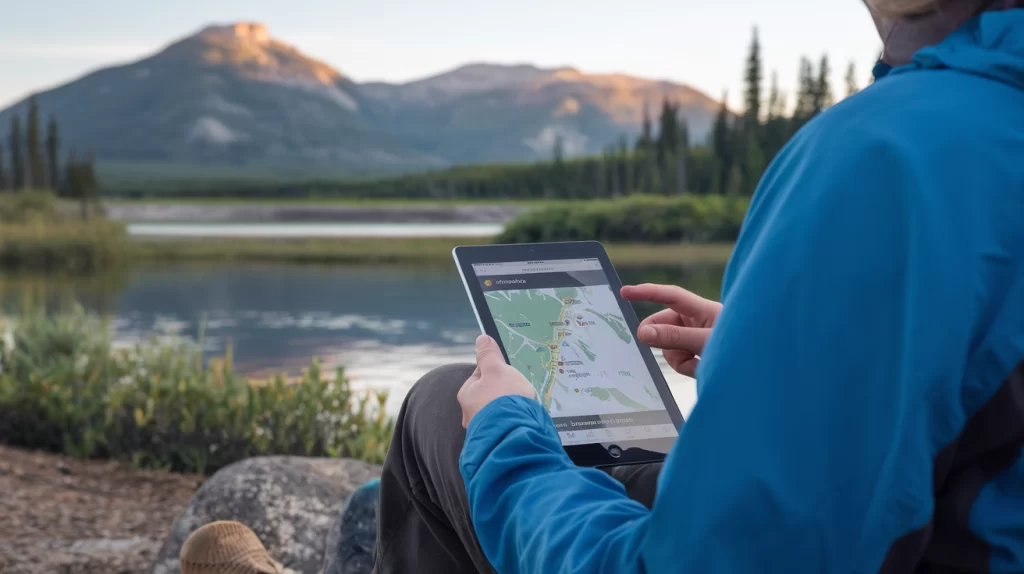
How to Find BLM Camping Locations
One of the challenges of BLM camping can be locating suitable campsites. However, with the right resources and tools, finding your perfect spot in the wilderness becomes an exciting part of the adventure. Here are some effective methods to discover BLM camping locations:
Official BLM Website
The BLM’s official website offers a comprehensive search tool that allows users to filter by state, recreational activities, and amenities. This site provides detailed information on regulations, site-specific rules, and access to maps for planning your trip. It’s a great starting point for finding both developed and dispersed camping areas.
Campendium App and Website
Campendium is a user-generated platform with reviews of BLM sites, offering GPS coordinates, photos, and tips on amenities. This app also provides valuable information on cell phone coverage, which can be crucial in remote areas where service is limited or unavailable.
iOverlander App
iOverlander is another user-generated platform with a global reach. It includes BLM sites alongside other types of camping locations and offers offline functionality, which is useful in areas without cell service. This app is particularly helpful for road travelers and overlanders seeking both remote and accessible campsites.
Free & Open-Source Apps
For campers looking for cost-effective options, free and open-source apps like OsmAnd, Gaia GPS (Free Version), and OpenStreetMap offer excellent tools for finding BLM campsites. These apps provide essential map layers, GPS functionality, and offline access. For a full breakdown of these tools, check out our guide: Free & Open-Source Solutions for Finding Campsites.
Local BLM Field Offices
Your nearest BLM field office is an invaluable resource for up-to-date information on local conditions and regulations. These offices often have detailed maps and brochures available, and staff can provide personalized recommendations based on your specific needs or preferences.
Online Communities
Forums such as Reddit’s r/BLMCamping and dedicated Facebook groups are excellent resources for real-time advice, trip reports, and tips from experienced campers. These communities are great for asking specific questions about particular areas or sharing your own experiences.
National Geographic Adventure Maps
For those who enjoy using physical maps, National Geographic Adventure Maps are detailed topographic maps that often include BLM land boundaries. These maps are available for many popular outdoor recreation areas and are useful for planning routes and identifying potential campsites, particularly in remote regions.
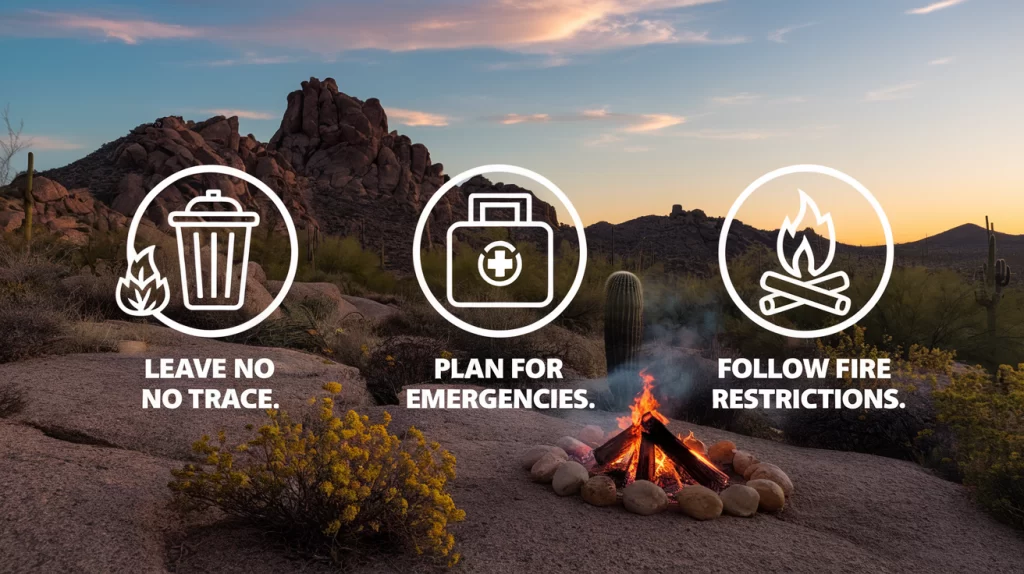
Key Considerations for BLM Camping
While BLM camping offers unparalleled freedom, it also requires careful planning and adherence to regulations. Here are the key factors to consider to ensure a safe, enjoyable, and responsible camping experience:
1. Rules and Regulations
BLM camping is generally more flexible than other forms of camping, but there are still important rules to follow to protect both the land and your experience:
- Length of Stay: Most BLM areas have a 14-day limit within a 28-day period. After this, campers must move at least 25 miles from their original site. For more information, check the BLM’s official regulations.
- Leave No Trace: Adhering to Leave No Trace principles is crucial for preserving the natural environment. This includes packing out all trash, minimizing campfire impacts, and respecting wildlife to ensure these lands remain pristine for future generations.
- Campfires: Always check for fire restrictions, especially in areas prone to wildfires. When allowed, use existing fire rings or create a minimal impact fire to reduce your environmental footprint. Check current fire restrictions on the BLM fire page.
- Vehicle Use: Stay on designated roads and trails. Cross-country travel is generally prohibited to protect fragile ecosystems and wildlife habitats. For details on designated areas, see the BLM off-highway vehicle guidelines.
- Group Size: Some areas may have restrictions on group size, especially for large gatherings. It’s important to check area-specific rules before planning a group trip.
- Permits: While most dispersed camping doesn’t require permits, some popular or sensitive areas might. Always check local regulations and permit requirements before your trip.
2. Safety and Preparedness
Camping in remote BLM areas requires thorough preparation to ensure safety in areas where services and amenities may be limited or non-existent:
- Water: Bring ample water or have a reliable way to purify water from natural sources. A good rule of thumb is one gallon per person per day. Consider using a portable water filter or purification tablets if relying on natural water sources. Learn more at the CDC’s safe water treatment guide.
- Food and Food Storage: Pack enough food for your trip plus extra in case of emergencies. Use bear-resistant containers or proper food storage techniques to avoid attracting wildlife. For safe food storage practices, consult the National Park Service bear safety guide.
- First Aid Kit: A comprehensive first aid kit is essential. Know basic first aid and consider taking a wilderness first aid course to prepare for potential emergencies.
- Navigation Tools: Bring maps, a compass, and a GPS device. Don’t rely solely on your phone, as service may be limited or non-existent. The BLM hiking resources offer detailed maps and navigation tips for various public lands.
- Weather Awareness: Check weather forecasts before your trip and be prepared for sudden changes. Bring appropriate clothing and gear for various conditions, including rain, wind, and cold temperatures.
- Emergency Communication: Consider bringing a satellite communication device, such as a personal locator beacon (PLB), for emergencies in areas without cell service.
- Inform Others: Always let someone know your planned route and expected return date to ensure help can be dispatched if needed. Informing others of your itinerary is a crucial step when venturing into remote wilderness areas.
3. Environmental Impact
Minimizing your impact on the environment is crucial when BLM camping. By following the Leave No Trace principles and being mindful of your surroundings, you can help preserve the natural beauty of these lands for future generations.
- Campsite Selection: Choose campsites on durable surfaces, such as gravel, rock, or dry grass, and camp at least 200 feet from water sources to protect the area around lakes and streams. For more guidance on campsite selection, refer to the Leave No Trace site selection guidelines.
- Waste Disposal: Always pack out all trash and waste, including biodegradable items. For human waste, use established facilities when available, or bury waste in catholes 6-8 inches deep and at least 200 feet from water sources to avoid contamination. Detailed waste disposal guidelines can be found on the BLM waste management page.
- Wildlife Interaction: Observe wildlife from a distance and never feed animals or leave food unsecured. Feeding wildlife can disrupt their natural behaviors and increase the chances of negative human-animal interactions. Learn more about safe wildlife interaction from the National Park Service wildlife safety tips.
- Plant Life: Stay on established trails and avoid trampling vegetation. Venturing off designated paths can damage fragile ecosystems and contribute to soil erosion. For tips on how to protect local flora, visit the BLM plant conservation resources.
- Cultural Resources: Many BLM lands contain important archaeological sites and cultural resources. Observe these areas respectfully, but do not touch or remove any artifacts. Removing or damaging cultural resources is illegal and can harm the preservation of history. For more information on preserving cultural heritage, check the BLM cultural heritage page.
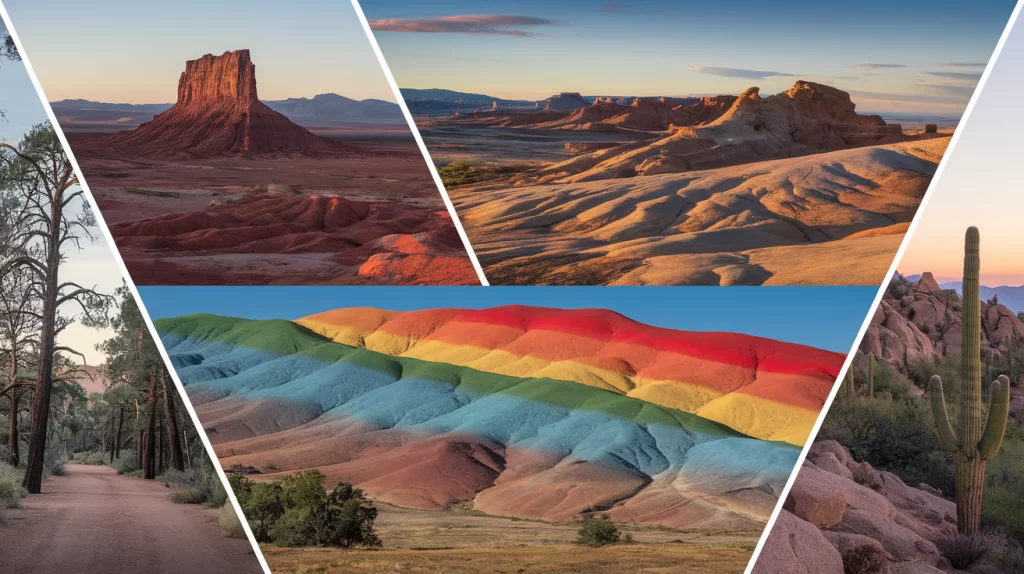
Popular BLM Camping Destinations
While BLM lands offer countless opportunities for camping, some areas stand out for their exceptional beauty, unique features, or recreational opportunities. Here are some popular BLM camping destinations that provide unforgettable outdoor experiences:
Alabama Hills Recreation Area, California
“During a solo camping trip to the Alabama Hills, I was amazed at the serenity of the desert landscape. The early morning views of the Sierras were breathtaking, and I had the entire site to myself. It’s moments like these that remind me why BLM camping is a true escape from the everyday hustle.” – Cindy Miller
- Location: Eastern Sierra Nevada, near Lone Pine
- Features: Dramatic rock formations, famous as a movie filming location
- Activities: Rock climbing, hiking, photography
- Best Time to Visit: Spring and fall for milder temperatures
Alabama Hills offers a stunning backdrop of rugged rock formations with the Sierra Nevada mountains in the distance. Its unique terrain has attracted filmmakers for decades, and it remains a top destination for outdoor enthusiasts. For more information on visiting this area, visit the BLM Alabama Hills page.
Valley of the Gods, Utah
“We’ve been BLM camping for years, and our favorite destination is Valley of the Gods. It’s the perfect spot for stargazing without the crowds. Our kids love it, and we always feel safe and connected to nature.”
– The Johnson Family
- Location: Southeastern Utah, near Mexican Hat
- Features: Red rock monoliths, wide-open desert landscapes
- Activities: Scenic drives, photography, stargazing
- Best Time to Visit: Spring and fall to avoid extreme temperatures
Valley of the Gods offers a serene desert experience with stunning red rock formations. It is a great spot for photography and stargazing, with minimal light pollution and clear desert skies. Learn more about this scenic area from the BLM Valley of the Gods page.
Cebolla Canyon, New Mexico
- Location: West-central New Mexico
- Features: Rugged terrain, ancient petroglyphs
- Activities: Hiking, archaeological exploration
- Best Time to Visit: Spring and fall for comfortable hiking weather
Cebolla Canyon offers a mix of rugged landscapes and rich history, with ancient petroglyphs found throughout the area. It’s a perfect destination for those interested in both nature and archaeology. Visit the BLM Cebolla Canyon page for more details.
Cochise Stronghold, Arizona
- Location: Dragoon Mountains, southeastern Arizona
- Features: Granite rock formations, diverse ecosystems
- Activities: Rock climbing, birdwatching, hiking
- Best Time to Visit: October to April for cooler temperatures
Cochise Stronghold is renowned for its impressive granite formations and is a prime location for rock climbers and birdwatchers alike. The area is steeped in history and offers a variety of hiking trails through diverse ecosystems. Learn more at the BLM Cochise Stronghold page.
Painted Hills, Oregon
- Location: John Day Fossil Beds National Monument, central Oregon
- Features: Colorful layered hills, fossil beds
- Activities: Photography, hiking, geology exploration
- Best Time to Visit: Spring for wildflowers, fall for vibrant colors
The Painted Hills are famous for their colorful, stratified layers of earth, providing a stunning visual display. Visitors can explore hiking trails that reveal both natural beauty and geological history. For planning your visit, see the BLM John Day Fossil Beds page.
Moab, Utah
- Location: Eastern Utah
- Features: Red rock landscapes, proximity to Arches and Canyonlands National Parks
- Activities: Mountain biking, off-roading, rock climbing
- Best Time to Visit: Spring and fall for ideal outdoor conditions
Moab is a hub for adventure seekers, offering world-class mountain biking, rock climbing, and off-roading. Its proximity to Arches and Canyonlands National Parks makes it a perfect base for exploring some of the best red rock landscapes in the country. Visit the BLM Moab page to learn more.
Steens Mountain, Oregon
- Location: Southeastern Oregon
- Features: Diverse landscapes from desert to alpine
- Activities: Hiking, wildlife viewing, stargazing
- Best Time to Visit: Summer and early fall when high-elevation roads are open
Steens Mountain offers a diverse range of landscapes, from high desert plains to alpine meadows. It is an excellent location for wildlife viewing, hiking, and stargazing due to its remote location and dark skies. To plan your visit, check the BLM Steens Mountain page.
What to Pack for BLM Camping
Proper packing is crucial for a successful and enjoyable BLM camping experience. Here’s a comprehensive list to ensure you’re well-prepared for your adventure:
Shelter and Sleeping
- Tent appropriate for the climate
- Sleeping bags rated for expected temperatures
- Sleeping pads or air mattresses
- Pillows
- Tarp (for additional shelter or ground cover)
Cooking and Food
- Portable stove and fuel
- Cooking utensils (pots, pans, plates, cups, cutlery)
- Cooler for perishables
- Food storage containers
- Water containers and water treatment method (filter, purification tablets)
- Biodegradable soap
- Trash bags
- Can opener
- Lighter/matches in a waterproof container
Clothing
- Weather-appropriate clothing (layers are key)
- Rain gear
- Sturdy hiking boots
- Camp shoes
- Hat for sun protection
- Warm hat and gloves (if camping in cooler weather)
- Extra socks
Navigation and Safety
- Maps of the area
- Compass
- GPS device
- First aid kit
- Emergency blanket
- Whistle
- Knife or multi-tool
- Flashlight or headlamp with extra batteries
- Fire extinguisher
- Bear spray (if in bear country)
Personal Items
- Toiletries
- Sunscreen
- Insect repellent
- Medications
- Hand sanitizer
- Toilet paper
- Trowel for digging catholes
Miscellaneous
- Camera
- Binoculars
- Field guides (for plants, animals, stars)
- Notebook and pen
- Portable charger/power bank
- Repair kit (for tent, sleeping pad, etc.)
- Duct tape
- Cord or rope
Recreation
- Hiking daypack
- Fishing gear (if planning to fish)
- Climbing gear (if planning to climb)
- Biking gear (if planning to mountain bike)
Conclusion: Embracing the BLM Camping Experience
BLM camping offers a unique opportunity to connect with nature in its most raw and beautiful form. From the rugged deserts of the Southwest to the lush forests of the Pacific Northwest, these public lands provide a vast playground for outdoor enthusiasts of all levels.
As you embark on your BLM camping adventure, remember that with great freedom comes great responsibility. By adhering to Leave No Trace principles, respecting wildlife and cultural resources, and properly preparing for your trip, you play a crucial role in preserving these lands for future generations.
Whether you’re seeking solitude under a star-filled sky, adrenaline-pumping outdoor activities, or simply a budget-friendly way to explore America’s natural wonders, BLM camping has something to offer. It’s an invitation to step off the beaten path, challenge yourself, and create memories that will last a lifetime.
So pack your gear, chart your course, and set out to discover the hidden gems scattered across America’s public lands. The wilderness is calling, and your next great adventure awaits on BLM land.
Call to Action
Are you ready to embark on your BLM camping journey? Start by exploring the official BLM website or downloading one of the recommended apps to discover your ideal campsite. Connect with fellow campers in online communities, share your tips, and learn from others’ experiences. Most importantly, venture out and enjoy the stunning public lands that are waiting for you. Your next great adventure is just a click away!
Have you camped on BLM land before? We’d love to hear your stories! Share your experiences in the comments below or join the conversation on social media by tagging us with #BLMCamping. Let’s showcase your favorite spots and inspire others to explore the great outdoors!
References
- Bureau of Land Management. (n.d.).
- Outdoor Industry Association. (2021). Outdoor Participation Trends Report.
- Leave No Trace Center for Outdoor Ethics. (n.d.). The 7 Principles.
- American Hiking Society. (n.d.). Hiking Safety.
- National Geographic. (n.d.). Adventure Maps.

